This project is made possible through the partnership of WATER CHARITY and the NATIONAL PEACE CORPS ASSOCIATION. ![]()
This project has been completed. To read about the conclusion, scroll down the page.
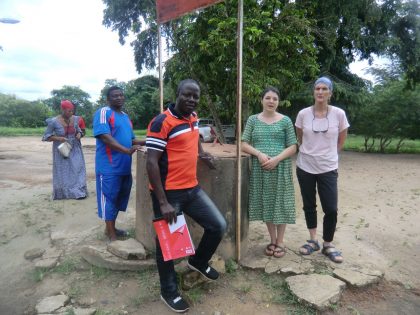 Location
Location
Alibi 1, Tchamba District, Centrale Region, Togo
Community Description
The village of Alibi 1 (population 2,000) is located in the eastern part of the Centrale region of Togo, 10 km south of the town of Tchamba, and roughly 30 km from the Benin border to the east. The Alibi 1 health clinic, however, serves a much larger population of 7,400 inhabitants from several neighboring villages, some as far as 18 km from Alibi. The nearest other health center is in the town of Tchamba.
Several ethnic groups live in the village: Tchamba, Kabié, Fulani, and Moba with Islam the dominant religion, though there are small Christian congregations. Livelihoods are centered around subsistence-level agriculture in the cultivation of manioc, yam, soy, rice, sorghum, and millet.
A prior Peace Corps volunteer successfully initiated an extensive rabbit husbandry project with (20) households participating. However, a lack of a market, aside from village consumption, has lessened the enthusiasm for continued production. The interest in animal husbandry is to generate income and less focus on much-needed protein consumption. There is however a growing cashew nut cultivation, as the Tchamba region overall produces enough cashew nuts for export to foreign markets.
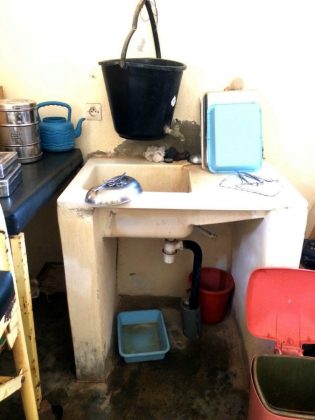 Two ephemeral rivers (rivers which flow for very short periods following heavy rainfall) run through the village, allowing for some river gardening, though a lack of motor pumps to irrigate the gardens that cannot be irrigated by gravity flow limits this effort. There is no electric power in Alibi 1 and only a limited household use of solar panels.
Two ephemeral rivers (rivers which flow for very short periods following heavy rainfall) run through the village, allowing for some river gardening, though a lack of motor pumps to irrigate the gardens that cannot be irrigated by gravity flow limits this effort. There is no electric power in Alibi 1 and only a limited household use of solar panels.
The Alibi water supply consists of 43 shallows, mainly open wells (without hand pumps) of which 70 % run dry during the dry season- beginning around February.
There are 7 borehole wells in the village of which 4 are functioning, though the water quality is poor and of limited yield, suggesting these borehole wells maybe be only slightly deeper than the open hand-dug wells. Shallow wells of less than 20 meters tap into a less productive subsurface zone, thus not reaching the deeper higher yield aquifer.
There is currently a Peace Corps Volunteer (PCV) serving in Alibi 1. Though technically an environment and agriculture sector PCV, her work includes assisting the midwife during family planning and STD sessions for school-age girls. This volunteer is the second consecutive PCV to be placed in Alibi, and like her predecessor is a competent volunteer with excellent communication and community engagement skills, with close ties to both the leaders and the general population.
Alibi I Clinic Description:
The health clinic at Alibi 1, constructed in 2005 by a national NGO (“Together with Togo”), is a typical 6- room cement block structure of approximately 1,000 ft**2 including a receiving area. Solar panels power the clinic with light and the refrigerator, used for vaccines and medicines.
The clinic is staffed by a head nurse, a midwife, a “pharmacist” who dispenses medicines and manages the clinic account, community health workers who work directly with the households primarily on malaria prevention and maternal-child nutrition, and a housekeeper. As with all of the local clinics, the Ministry of Health supports the head nurse and usually the mid-wife while the community is responsible for the remaining staff.
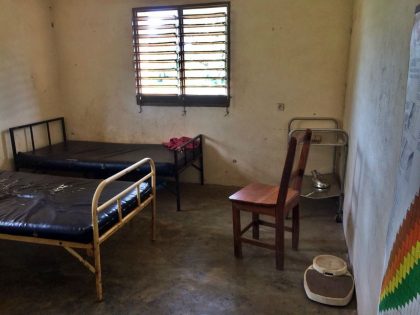 The majority of health concerns seen by clinic staff include malaria, gastro-intestinal diseases, surface infections, and births. The number of births per month ranges from 8 to 20. Complications resulting in non-vaginal births are addressed at the district hospital in Tchamba or Sokode, the regional capital.
The majority of health concerns seen by clinic staff include malaria, gastro-intestinal diseases, surface infections, and births. The number of births per month ranges from 8 to 20. Complications resulting in non-vaginal births are addressed at the district hospital in Tchamba or Sokode, the regional capital.
The maternity services offered at the clinic are particularly impacted by the lack of running water inside the building thus requiring female relatives to provide water to assist during birth and post-birth clean-up. The Alibi clinic also sees young women (often in middle and high school) interested in family planning and birth control (typically implants are administered), who also receive education on sexually transmitted diseases and family planning.
In late 2017, a Peace Corps Volunteer in a neighboring Muslim village, in conjunction with the local Imams (Islamic religious leaders) organized a family planning workshop that included birth control, resulting in a noticeable rise in family planning attendance since the workshop.
Alibi 1 clinic serves a number of outlying villages including a community of nomadic Fulani herders. The relationship between Alibi 1 and the Fulani community is an unusually positive relationship (as a whole, Fulani are a marginalized ethnic group due to their nomadic lifestyle) in large part due to a shared religion, and a long-standing positive relationship between the heads of both communities. As a result, the Alibi 1 clinic serves an unusually large number of Fulani women and girls who otherwise would not seek out health care in a public health center, and thus would not benefit from the maternity services thereby continuing to give birth at home with the associated risks.
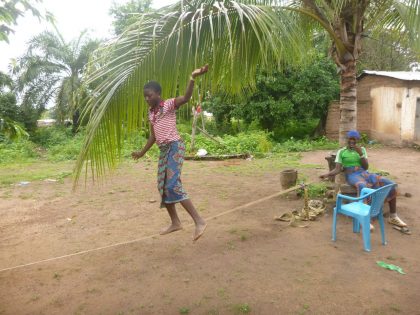 Problem Addressed
Problem Addressed
When the clinic was constructed in 2005, a shallow 10 m open well was dug on the premises as the sole water source for the clinic. There was, and continues to be, no indoor plumbing in the clinic, with the exception of a make-shift sink in one room where a drain pipe was later added to discharge waste through an opening in the floor into a closed cistern outside. Water is drawn manually by girls and women (usually the relatives of patients) using a rope and rubber container, also a source of contamination as little care is given to the cleanliness at the foot of the well or of the containers used to draw water.
Given the ephemeral subsurface water source tapped by this well (and other shallow wells in the village), depletion of water occurs mid-dry season usually around the end of February-March, resulting in four months of water scarcity. During this period, water is brought to the clinic from the few producing wells by foot or three-wheel motorcycles. Water quality is also compromised in this shallow zone by the infiltration of fertilizer resulting in abnormally high concentrations of nitrate, as noted in water testing of regional wells.
In 2015, a local NGO funded from abroad drilled a borehole well on the clinic grounds equipped with a manual hand pump, however, the well never properly functioned and currently yields water with a high sediment (clay) concentration. Given the depletion of water from this source by early March, the depth of the well is assumed to be comparable to the open hand-dug well. The clinic staff understood this well to be a deeper borehole well and was evidently funded as such. The locally-based drilling company acted independently with no oversight by the Department of Hydraulics and Sanitation. The Department is typically not consulted when external NGOs work directly through the mosques, churches and local organizations. Unless the drilling company is both technically competent and honest, the absence of oversight can result in a poorly executed water supply and a lack of subsequent monitoring.
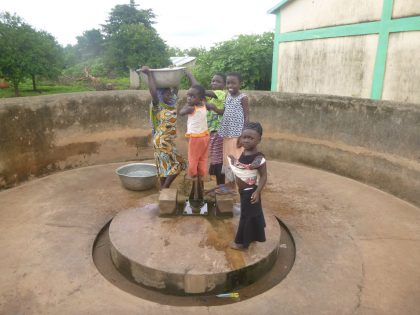 Water is brought into the clinic from these two wells located on the property and stored in buckets and water jugs. Water is treated with bleach, though not uniformly throughout the clinic nor regularly. The clinic currently uses both well sources of water during the rainy season, allowing the sediment from the borehole well to settle prior to use though neither source (open well or closed borehole well) is considered potable.
Water is brought into the clinic from these two wells located on the property and stored in buckets and water jugs. Water is treated with bleach, though not uniformly throughout the clinic nor regularly. The clinic currently uses both well sources of water during the rainy season, allowing the sediment from the borehole well to settle prior to use though neither source (open well or closed borehole well) is considered potable.
Drinking water for staff and patients is typically brought in from outside sources when the local water quality is particularly poor and treatment with bleach is inadequate.
Project Description
This project is to build a borehole well for the Alibi clinic. Under the guidance of the Department of Hydraulics and Sanitation’s regional office in Sokode and with support from the Ministry of Health regional director, who identified clinics with the most critical need, and a local drilling company, this project proposes to drill a 60- to 100-meter borehole well at the clinic, equipped with the following:
• An electric submersible pump,
• a 4-meter high cement block water tower,
• a 2 meter**3 polyethylene tank, and
• indoor plumbing (water basin and faucet) to the one room with a subsurface drain (mentioned above).
The submersible pump will be run using a gas-powered generator as there is currently no electric power in Alibi 1. The local drilling company selected, Plomberie Génerale de Réalisation de Forage, in operation since 1998 and based in Tchamba, has extensive experience drilling deep borehole wells throughout Togo and regionally in Burkina Faso, Benin, and Nigeria.
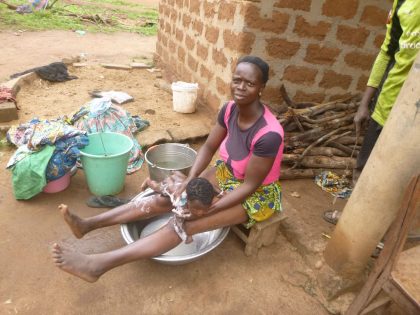 Water Charity recently funded a PCPP borehole well project in the village of Dagma – implemented by this company. The owner-head driller understands the importance of community participation and consistent monitoring and support as needed.
Water Charity recently funded a PCPP borehole well project in the village of Dagma – implemented by this company. The owner-head driller understands the importance of community participation and consistent monitoring and support as needed.
Prior to drilling, a geophysical study using resistivity will guide the placement of the borehole. The deeper, higher-yielding aquifer is within a network of dense and open fractures in a crystalline granodioritic bedrock, which itself is impermeable. However, the open fractures allow for the infiltration of water into two distinct zones of groundwater storage, a discontinuous zone with lower transmissivity, and a more favorable altered zone with both high porosity and transmissivity. The latter is the zone favored for borehole drilling where high-quality water is typically found at depths of 42 to 90 meters, depending on the topography. Transmissivity in these zones varies from 2 to 15 meters3.
A sustainable pumping rate of 800 liters/hour will be sought during well development which for a village of 300 persons is considered to be a minimum yield. The size of the water tank is designed to run the generator on a weekly basis as water is stored in the polyethylene tank above the water tower and enters the clinic through gravity feed.
The Alibi 1 community has agreed to provide as their contribution sand, gravel and water for the fabrication of cement bricks used to construct the water tower (including transporting of material to the drill site), housing for the drilling crew, and secure housing for drilling equipment.
The Department of Hydraulics and Sanitation typically receives funding from the project for project oversight (monitoring and evaluation) as each regional state office operates independently from the national agency in the capital. At least for the initial suite of borehole wells funded through the Togo Water Initiative, the Department has agreed to waive this fee as their contribution.
Project Impact
7,400 people will benefit from the project.
Project Administration
This project will be managed by Anne Jeton, hydrologist and Returned Peace Corps Volunteer (RPCV), Burkina Faso (’82-’85) and Returned Peace Corps Response Volunteer (RPCRV), Togo (’16 -’17), Anne was sent to Togo on behalf of Water Charity to develop and administer new projects, and to coordinate with Peace Corps.
Monitoring and Maintenance
Along with staff from the Department of Hydraulics and Sanitation who will monitor the well “indefinitely” (the well data becomes part of the official borehole well database, and as such is included in periodic field monitoring by technicians based in each Prefecture ), the contract for well drilling states a one-year guarantee provided by the drilling company. Problems with pump and borehole functioning are typically resolved in the first month of use.
Proper screening of the borehole and submersible pump placement relative to the static water table often mitigates the most common problems. However, any mechanical problems surfacing in the first year will be the responsibility of the drilling company.
The hydrologists and drilling company owners have met with the clinic staff and community leaders where expectations and responsibilities pre-, during- and post-well construction was outlined. The clinic staff will be responsible for maintaining a well repair account which will be funded from the sale of medicines.
The Community Development Committee (present in all villages in Togo) will solicit unmet funds from the community should a need arise to maintain the water supply infrastructure in good working order. As potable water is lacking in Alibi, particularly during the dry season, the clinic staff will decide when and at what cost water will be provided to the community, understanding the needs of the clinic are the priority. Utilizing the pump more frequently than necessary for clinic use will increase fuel consumption which will be the responsibility of the clinic to pay.
The clinic will decide a nominal fee for water use should the water account be insufficient, or the community will be asked to contribute directly to the costs.
Though this project is not a Peace Corps project, the PCV at the site has indicated an interest in helping to motivate the community insofar as their participation during construction and a one-year follow up/evaluation.
Project Funding
This project has been funded by an anonymous donor.
Conclusion of Alibi 1 Clinic Borehole Project – Togo
The percentage of the total population in the Tchamba District with access to potable water is estimated to be only 38 percent. In the Centrale region, only 41% of the population is estimated to have potable water hence the need is immense. The current Togo water assistance program in Togo chooses to focus on village-level health care clinics with the intention of addressing both a health care need and providing potable water to the surrounding neighborhoods during months of water scarcity.
The maternity delivery room was equipped with a sink, faucet and running, potable water, and through additional outside funding; a floor drain and a discharge chamber, both plumbed to a dedicated subsurface cement-lined and ventilated septic tank. Delivery room waste (blood and tissue) can now be dispensed with directly in the maternity room in a safe and hygienic manner, rather than hand-carried by the midwives to an outdoor pit or in many cases poured into the latrines.
Togolese Ministry of Health’s regional office compiled a list of community health clinics in critical need of water for each of the four districts within the Central Region. These community health clinics are run by the Ministry of Health and are the first rung of health care services designed for rural communities, known locally as a Unité Soins Périphérique or “USP” (hereafter refers to as “ health clinic”) typically staffed with a salaried licensed nurse and midwife. Other personnel at the clinic often include a midwife assistant, a “pharmacist” i.e. someone who dispenses medicines with the supervision of the head nurse, and a community member trained in basic accounting skills to manage the clinic account. The clinic typically cares for a range of illnesses, most prominently malaria, gastro-intestinal and respiratory ailments, and surficial infections. However, providing women with maternity care, pre and post-birth, was the primary reason for their establishment several decades ago and has since been the main emphasis of these rural clinics.
The scope of the current Water Charity assistance program managed by the in-country coordinator is to meet this water scarcity by installing deep borehole wells and a water distribution system to provide yearlong, potable water into the clinic, thus enabling the clinic to better serve the community through a cleaner, more hygienic environment. By maintaining appropriate hygiene in the clinic by using uncontaminated water, the presence of pathogens should be reduced. Indoor plumbing in the clinic will alleviate the burden on both the clinic staff in general and in particular the mid-wives who typically operate under severe and very unhygienic conditions.
Additionally, the added burden imposed on the female relatives of expectant mothers to fetch water from the open, unpotable clinic well (during the rainy season) or further to distant sources during the dry season will be eliminated. The health clinic borehole well program uses the term “borehole” to refer to the mechanical insertion of a vertical pipe ( or casing) with a modern, mechanized drilling rig to depths typically between 60 and 100 meters to reach water-filled fractures, and not a hand-drilled borehole used in some countries with shallower depth to a water table.
Initial site assessment of a designated health clinic (including Alibi 1) were carried out by the Department of Hydraulics hydrologist and the Water Charity coordinator where the following information was collected to determine the feasibility of a borehole well distribution system in consultation with both clinic staff and community leaders:
– Date of construction of the clinic and by whom.
– Water system installed at the time of clinic construction and any subsequent changes including maintenance by the clinic staff.
– Current power source (solar, electricity, generator).
– Staff positions and numbers are funded by the community.
– Assessment of clinic infrastructure (building, plumbing, septic, presence and or condition of latrines)
– Frequency of patients and type of illnesses treated, number of births per month, community training (for example family planning, STD, HIV, maternal-child nutrition)
– Community oversight by leaders – community development organization, village heads and religious leaders (Imams).
– Financial soundness of the clinic insofar as the ability to provide maintenance and upkeep and to pay for fuel to run the generator for those clinics without power, or for the later, to make a regular payment to prevent disruptions of service.
All of the health clinics visited were in critical need on the water however given the limitations in funding, the final determination of a project site was based on several factors including; the motivation of the clinic staff to responsibly managed the borehole well water system to ensure future repairs, the community leaders to contribute building material and labor during well implementation, the presence of an established water committee to manage community access to the well during months of water scarcity, the viability of the clinic itself i.e. frequency of clinic visits, and financial means (and willingness) to create a separate well repair account.
Alibi 1 has a dynamic and motivated community, having been the recipients of a both Peace Corps funded project and NGO assistance. Alibi 1 met the project criteria discussed above. The purpose of the borehole well project at the Alibi 1 health clinic was to address both a shortage of year-round water and unpotable water at the clinic, to provide the maternity room running water as the clinic had no prior indoor plumbing, and to make available to the community on an as specified basis, water during times of scarcity. The scope of the borehole project entailed drilling a 60-meter borehole well, properly “developed” using modern technology and equipment; equipping the borehole with an electric submersible pump, constructing a 4.5-meter high cement block water tower topped with a 2,000-liter polyethylene water tank, installing a gas-powered generator as no electric power is available in village, outdoor water access points (faucets next to the clinic), a water access point on the water tower for community members, and the servicing of the well to the indoor plumbing.
WORK ACCOMPLISHED (progression of work through each stage)
1) Site assessment of the existing water system. Community meetings with village leaders, community development members, and the health clinic staff to discuss the feasibility of the project relative to the community contribution (labor, housing for drill crew and building material for the cement water tower. In addition, the financial strength of the clinic budget was assessed and the motivation of the clinic staff to maintain the well system in constant working order. Discussed the ability of the clinic staff to install the indoor plumbing necessary as the project limits its scope to borehole well, water tower, power source, and plumbing for both outside and indoor access.
2)A geophysical field study lead by a Togolese firm (overseen by the drilling contractor) was implemented to determine borehole drill placement using the electric resistivity method to locate deep-seated water-filled fractures (or fissures). Knowledge of prior hydrogeological investigations assisted in assessing potential locations. Borehole placement was identified based on geophysical indicators of a fracture-filled water aquifer (defined as a “saturated permeable geologic unit that can transmit significant quantities of water under ordinary hydraulic gradients” [Freeze and Cherry, 1979. Groundwater p.47].
3) A local Togolese drilling company based in Tchamba with extensive experience was hired to oversee the borehole well water system for the Alibi 1 health clinic. The Department of Hydraulics Director prepared a contract stipulating the conditions, responsibilities, and timelines for the project, and agreed upon by the Water Charity Coordinator. A borehole drilling machine was brought to the clinic and the borehole site was prepared for drilling. The community provided a secure building for equipment storage and housing for the drill crew. A borehole well was drilled using an industry-standard rotary drilling machine attached to a flatbed truck which accomplishes two tasks; using rotation, a drill bit cuts away at the bedrock while PCV drill pipes are lowered progressively into the drilled or vertical “borehole”, in this case using the compressed air method. The well was drilled to a depth of 60 meters, through the lateritic overburden into the crystalline bedrock. Material brought to the surface during drilling was identified to assist the driller and hydrogeologist in classifying the geologic formations within the borehole (figure 1). The aquifer tapped by the borehole water is a confined aquifer ( where an impermeable layer lies above the aquifer thereby allowing groundwater flowing into the borehole to rise above the aquifer). The static water table (the water table before pumping) was at 8.8 meters, while the dynamic water table ( the water table during pumping at the desired yield) was at 43 meters. The well was screened (slits cut into the casing thus allowing groundwater to enter the borehole) between 48 and 57 meters and between 16 and 20 meters.
4) An electric submersible pump was inserted at 50 meters (within the lower screened segment of the well) and a pump test was initiated to determine the well’s productivity. Essentially the pump is run for several hours at a rate similar to actual pumpage use, the declining water table is measured at regular intervals and the return flow to the initially measured water table provides information on the transmissivity of groundwater through the subsurface material i.e. how rapidly the good recovers from pumping. Once a well is free of any accumulated fines, it can be properly evaluated for the amount of water it will yield. The Alibi 1 borehole was drilled to a depth of 60 meters and produced an average water yield of 4,000 liters/hour which is more than adequate to supply both the clinic’s needs and those of the surrounding households. The pump test also indicated a rapid filling of the borehole after pump use, implying even when running at the maximum yield rate, the well should recover quickly and not result in lag times. Simply put, the hydraulic conditions of the well are favorable to ensure a sustainable water supply for many years to come (assuming the system is well maintained).
5) Water samples from both the borehole well and the original clinic well were taken and sent to the Regional laboratory in Sokodé, the regional capital, for a complete microbial and inorganic compound analyses. The results of this analysis indicate zero presence of any of the disease-causing bacteria tested (E Coli, Salmonella, Fecal Streptococci, Enterococci and a general category of thermotolerant Coliforms) in the new borehole well. This is in sharp contrast to the water sample from the existing open well where all classes of the above-listed bacteria were present and in concentrations in the 100’s of counts per milliliter. The international standard is 0/100 ml. Of the inorganic elements tested (elements found in the bedrock, or soil in the case of the shallow well, and nitrate which is a product of fertilizer use and sewage/septic leakage ) both samples were within acceptable levels. The Alibi 1 open well, a typical shallow well common throughout the region, is very probably representative of many communal wells.
6) Construction of a 4.5-meter high cement block water tower equipped with a 2,000 liters polyethylene water tank. The community contributed sand, gravel, and labor in manufacturing the cement bricks needed for constructing the water tower.
7) Plumbing installed from the borehole well to the water tank and from the tank to both the outdoor faucets and the intake valve to the building allows for a gravity-fed routing of water, powered by a gas generator as there is no electricity at the clinic. Additional water spigots were installed at head height on the water tower to allow the community members (women) to fill their basins directly without having to lift heavy basins of water as is the case with hand pumps. The clinic opted to add another water line to the nurse’s examination room at their cost.
8) Numerous visits were made during the well installation by the Water Charity Coordinator and the government hydrologist to ensure the clinic and community leaders understood the responsibilities associated with maintaining and ensuring a sustainable water supply. A final visit by the Regional Director of hydraulics insured the borehole well and the associated delivery system met all of the driller’s contract requirements and functionality.
9) An official technical opening concluded the project with a presentation by the driller on the borehole well components, brief discourses by the Department of Hydraulics Regional Director, village leaders, and representatives from the regional ministry of health. Alibi 1 was well represented by the religious leaders of the predominantly Muslim community, male and female elders, children, community development members and some members of the general population. As the representative for Water Charity and its donor(s), the Coordinator reinforced previously discussed themes of maintenance and upkeep through the active participation of a community water committee and a clinic repair account, and to manage public access to the well in a non-disruptive manner to the clinic staff and patients, and most importantly to take ownership of this valuable resource.
Monitoring
The Department of Hydraulics will assume monitoring of the borehole well from a maintenance perspective for an indefinite period of time. The Department has on its staff personnel trained to work with community water committees and clinic staff. The contract states a one-year guarantee for the submersible well. Any technical problems that arise with the initial use will be addressed by the drilling company. The clinic staff does not foresee a need for the community to access the well water until later in the year when the local wells begin to dry up, except for the Peace Corps volunteer serving in Alibi 1 who is encouraged to use the well for personal consumption. While there has been much discussion around the issue of how the clinic will manage community access to the well, it remains to be seen how this will play out. The well is primarily for the clinic however, in water-scarce communities, water sources are shared.
Given the well is powered by a gas generator which the clinic is responsible for running and maintaining in constant working order, the clinic will collect a nominal fee from the users to be deposited into a separate account. The Alibi 1 clinic serves a population of approximately 7,000 people, including the neighboring villages. While clearly not all 7,000 people will be accessing the well water, the community development liaison estimated perhaps as many as 3,000 inhabitants will seek water during the months of water shortage ( from February on). The clinic anticipates seeing a rise in births as there is now running water and female relatives are no longer obliged to fetch water for the patient – not to mention the overall hygiene. The clinic staff will use access to potable water to encourage better overall hygiene given most of the disease-causing bacteria in the community water sources are due to fecal transmission by both animals and humans.
Conclusion
The Regional Director of the Department of Hydraulics stated in his technical report ( information included in this report on borehole characteristics and figure 1) the following as translated from French: “ The political view of the government of Togo states shallow wells on the order of 7 to 25 meters are considered unhygienic and unpotable. The subsurface zone at this depth receives only infiltrated water directly from the surface of water that flows laterally into this zone from contaminated sources (other wells, wastewater, septics, streams). Deep borehole wells reaching uncontaminated water is the only acceptable water for our population”. In this light, the Alibi 1 health clinic borehole well water system has fully succeeded in meeting both the local and national objectives for potable water. The community of Alibi 1 offers its sincere thanks and gratitude to the donor(s) for this valuable water resource. As they here “ l’eau est la vie”. Water is life, and the cleaner the water the longer and more satisfying than life will be! Un grand merci!